Celia Xakriaba is the voice of a new generation of female indigenous leaders who are leading the fight against the destruction of Brazil’s forests both in the Amazon and the lesser known Cerrado, a savannah that covers a fifth of the country. V, formerly Eve Ensler, is the award-winning author of the Vagina Monologues, an activist and founder of V-Day, a global movement to end violence against all women and girls and the Earth. The two recently held a conversation in which V asked Xakriaba about what is happening to Brazil’s biodiversity and indigenous peoples, and why women are the key to change.
V: Many people, especially in the west, don’t really understand what’s happening to the Cerrado in Brazil. Can you tell us what’s happening to the forests?
C: It’s very tough at this moment. Every minute one person dies of Covid-19, but also every minute one tree is cut. And whenever a tree is cut, a part of us is cut, a part of us also dies, because the territory dies and with no territory there is no air, no good air for everyone in the world. People can’t breathe. So all this Covid contamination, it gets to the territory through the miners, the gold miners, the loggers and the rangers. And now that we are getting to August, we get even more worried about the fires, all the fires that burned the Amazon last year. It’s going to come back.
Q&A What is Brazil’s Cerrado and why is it in crisis?
Show
Hide
The Xakriaba tribe, whose name Celia Xakraiba carries, is one of over 80 living in 109 indigenous reserves in Brazil’s vast Cerrado biome, a vast, tropical savannah stretching diagonally up through the middle of Brazil that covers 2 million sq km, around 22% of the country, as well as parts of Bolivia and Paraguay.
According to Brazil’s environment ministry, the biodiversity-rich Cerrado has 11,620 plant, 1,200 fish and 837 fish species and its 200 mammals include jaguars, anteaters, rhea birds and tapirs. But over half of its landscape – grassland scrub and dry forest – has been converted to agriculture as it produces soya for China, Europe and other markets. That production is threatened by climate change and the region lost 105,000 square kilometres of native cover from 2008-2018, according to Reuters – 50% more than the Amazon, which has more legal protection. Streams are drying up. One study at the University of Brasilia connected an 8.4% drop in rainfall over three decades in the Cerrado to land use changes.
According to a new international study published by Science magazine, around 27,000 properties in the Cerrado had carried out deforestation “in all likelihood illegally”, and 48% of properties were non-compliant with the requirements of Brazil’s forest code, such as protecting 20% of their land (compared to 80% in the Amazon). The study found around 20% of soya exports and 17% of beef exports from Brazil’s Amazon and Cerrado biomes to the European Union “may be contaminated with illegal deforestation”.
Another new study by researchers from the US’s Dartmouth College published in Nature Sustainability magazine found land clearing had changed the weather in the Cerrado. Temperatures were hotter during the corn growing season and evapotranspiration fell. Last year Brazil became the world’s biggest corn exporter, but the study showed yields of corn falling 6-8%.
“Our findings provide evidence that land clearing has degraded weather in the Brazilian Cerrado, undermining one of the main reasons for land clearing: rain-fed crop production,” the report said.
Last year, in an article published in Perspectives in Ecology and Conservation, scientists warned that “climate changes are likely to cause local extinctions of several mammalian species throughout the Cerrado biome”.
Dom Phillips in Rio de Janeiro
And what happens to all the animals, and to the birds and to every living thing in the forest? What happens to them?
When the forest is burned, the birds and the animals, they are either burned or they go away. And this doesn’t affect only the animals, but it also affects us. We rely on them to eat. So with no animals, we have to rely on food from the outside, and this ends up making our children and our women sick, here with the Xakriaba people. I can hear the song of the birds now, but it’s also a song of misery, of sadness, because most of them, they are alone. They have lost their partners. The birds, they usually sing as a couple. And many of them are now singing alone. And we, the indigenous are becoming more alone, because they’re taking people from us.
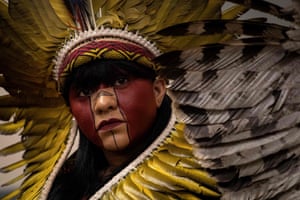
When I first met you, we laughed because we were talking about vaginas and you told me that the Amazon was the vagina of the world. So can you talk a little bit about that?
The Amazon’s like the vagina of the world because it’s where people come from. It’s like the entry door of the world. When this opening is sick, the future generations, they will be sick also. People lost this connection to the Earth because they don’t see Earth and land as a relative. For me, the Earth is like a grandmother, because it’s Earth who gave birth to all of the mothers of the world. Earth is like the first independent woman that created humanity and Earth needed rivers and water to create humanity. But now people just see Earth as a thing. They can design big cities, but they can’t see this connection to Earth. They go to the supermarket, to the grocery store, and they don’t know where that food comes from.
It’s so powerful to see how many indigenous women are leading the struggle to defend the forests and the land. Why do you think this is important?
I’ve been saying that this 21st century, it’s the century of the indigenous woman, because you can’t cure with the same evil that first caused the sickness. You have to overcome this colonising power that is mainly male. I like to say about the matrix of destruction that it’s not matrix, it’s the patrix because it’s based on patriarchy, not matriarchy. And the women, they are the ones who are in this century regaining power over the land, because they know how to cure the Earth. Women have this knowledge and that’s why we are on the frontline right now. I am fighting to not only strengthen the role of women in the territory and in the fight, but also in politics, with indigenous women running for positions in parliament, in the Brazilian Congress. Who can take better care of humanity, if not women?
Can you talk a little bit about how patriarchy has disconnected us from the land and the connection of patriarchy and capitalism?
When Pedro Alvares Cabral first invaded Brazil in the 1500s, the first thing that got his attention was the wood from the pau-brasil, which is where the name Brazil comes from. In 1511, this guy named Fernando de Noronha exported 5,000 pau-brasil to Europe. So that’s when it all began. Since then, they don’t respect the relation of the indigenous peoples with time. That’s why capitalism sees indigenous peoples as a threat. You have to take everything you can in as little time as possible, but that’s not how indigenous people relate to time and to labour. Yeah, the indigenous people weren’t keeping up with the “progress” of humanity but it’s not that we are late, it’s because they’re killing us. In the last year there was more than a million hectares of destruction in all the six biomes of Brazil. Since the 1500s, until now, no Earth, no land, no mother, no woman can support this kind of destruction.
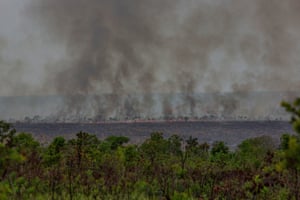
Can you tell me what is the lived experience of the struggle for life and the struggle of the indigenous peoples in this phase of the onslaught of the extractive industries, and now with Covid exacerbating the situation? What is happening?
During this pandemic we are making this effort to remain in our territories, in our houses, in our homes, but also at the same time, we have to challenge, to fight, because very far away in Brazil, in the Congress, they are negotiating our territories, our homes and our houses. During the pandemic, hundreds of indigenous people have died. But we have to think about how many people would die if we don’t fight. You have to think about the pandemic that is killing us, about the racism that is killing us, about the macro politics, about the colonisation, the absence of the state. It’s hard to tell which weapon is more dangerous, because we are getting killed by many different weapons.
It appears very clear that President Jair Bolsonaro has weaponised Covid against indigenous peoples. Can you talk a little bit about this?
Indigenous peoples in Brazil, they are 1% of the general population, but they’re almost 9% of the victims of Covid-19. When people say that Covid-19 doesn’t choose class or race or gender, it’s kind of a lie, because the state, they choose who will die. The government, it can justify all of this, saying that it’s just a disease, it’s a fatality. When an elder, when an important leader of indigenous peoples dies, a part of us also dies with them. It’s like the ancestors and the elders, they’re the hands that hold the rattles when you’re singing. It doesn’t matter if I stay alive, a part of me, or some parts of me have died in this pandemic.
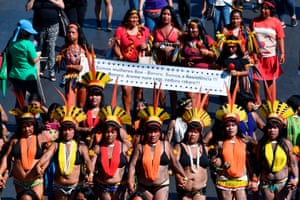
I love the campaign #CuraDaTerra [Cure of the Earth], because it expresses this idea of indigenous peoples as the cure, the antidote, the growth space past capitalism through living in symbiosis with nature, indigenous stewardship of land, traditional indigenous environmental knowledge. How is this being received in Brazil?
One thing that is very important is we pay attention to these things like reconnection, retaking, re-enchantment, because that’s one thing that indigenous people do to hope for a better world. It’s not the chemicals or the active principles generated in laboratories around the world that are going to cure the Earth. What is going to cure the Earth is our capacity, our ability to reactivate our connection to the Earth, to reactivate our culture and to reactivate the power of our ancestors. We have this culture deep inside us, and you can’t change that. We can’t cure evil without curing the Earth, because the Earth is bleeding. It’s full of scars because of its children. And if you don’t listen to the Earth, we will all die. Some people may not die directly in territory conflicts, but they will die, because they won’t have anything left to breathe. All they will have left is poison.
Like in the US, Brazil is going through a kind of dark night of the soul with Bolsonaro in power.
Bolsonaro likes to say that indigenous peoples are becoming more human, but the indigenous peoples don’t like the kind of humanity that doesn’t respect the Earth, doesn’t respect the animals, because you can only know how to be a human if you know how to be a plant, how to be a seed, how to be food. And so actually this project, it’s an anti-humanitarian project of the government. It represents a sick lung, a sick organ of the body of the Earth.
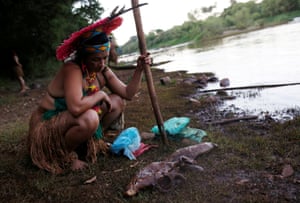
And why do you think at this moment that we have so many leaders in the world like Trump or Duterte or Modi or Putin or Bolsonaro?
All of this is because we are living in a moment of disputes, disputes of values. They are not part of this project of regaining and retaking the values of life. They are like boils on your skin, and they emerge with all the fury, these boils, like a cancer to these values of life. They emerge with this fury because they appear to have the desire to extinguish all diversity – the diversity of life, the diversity of culture, the diversity of seeds, the diversity of territory.
What is the mood and the feeling in Brazil right now?
Some people who thought we were invisible, they didn’t look, didn’t pay attention to the indigenous populations, now they’re starting to pay attention to us. And the indigenous people, they have within themselves the sense of solidarity and of connection that other peoples don’t have. And that’s something that can help heal the Earth and heal our world because humanity, without love, it’s a dead humanity.
And how do you stay grounded in the midst of all these changes happening in the Cerrado and then the planet at large?
The fight is what feeds me. So every time I think about taking a step away from the fight, I can’t. And as an indigenous person, you fight to survive. You don’t really have another choice. I think about the fight as the children that I haven’t generated yet, the children that I and the indigenous peoples will give birth to in the future. I remember that some time ago in another genocidal process that was going on, the leaders and the indigenous peoples weren’t allowed to paint themselves. So the women would keep these painting pots in their houses. It was a way of not forgetting the paintings and the patterns. And now when I think about that, I think about my body as a pot. I like to paint myself because it’s a way of getting all this memory eternalised, and not forgetting, because more than fighting, painting myself is a way of continuing what my ancestors were doing. Some feel pretty when they put on their best dress. I feel pretty when I paint myself. And it’s not only that. When I paint myself, I feed my spirit and I keep my mind strong. And my headdress gives power to my thoughts and to my fight. So, when I paint myself, when I put my headdress on, I’m not only doing that to show others, I’m doing that to keep myself, my mind and my spirit strong and fed, to keep singing.
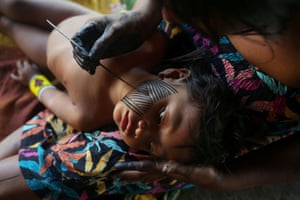
What can allies in the global north do to be in solidarity with you, your community, and the affected communities of Brazil?
People can fight along with the Indigenous peoples as if they were fighting for their own children. Because when you fight together with indigenous peoples, it’s not just a matter of solidarity. It’s like you’re fighting for your own family, your own children, your own grandchildren, because the indigenous populations, they protect around 82% of the world’s biodiversity.
What’s your vision of the future?
My hope for the future is being alive. And by that I don’t mean just my body being alive. But our voice has to be alive. Our memory, our chants, our singing, and our womb, because you can’t be alive in your body if the womb of the Earth is sick, because when the Earth is sick, we can’t get food. And what’s the point of keeping your body alive if all around you is dead?
And lastly: please describe your vision of what the “re-enchantment” means.
Re-enchantment is within us. People are very worried about this Covid emergency, about being able to touch other people and to feel an effect, a love of affection for other people. But what really is this re-enchantment? It’s the love that we feel for the rivers, for the forest, for food. We have to think that the real borders of the world, it’s not the borders between Brazil and the United States, or between the Amazon and the Cerrado. The real borders of the world are the borders between racism and biodiversity. We can’t drop this fight. We have to keep fighting for the biodiversity, for this cure of the Earth, and for our territories, because one who has territory has a place to return, and one who has a place to return has refuge, has warmth. And that’s why we need to keep fighting.
Find more age of extinction coverage here, and follow biodiversity reporters Phoebe Weston and Patrick Greenfield on Twitter for all the latest news and features